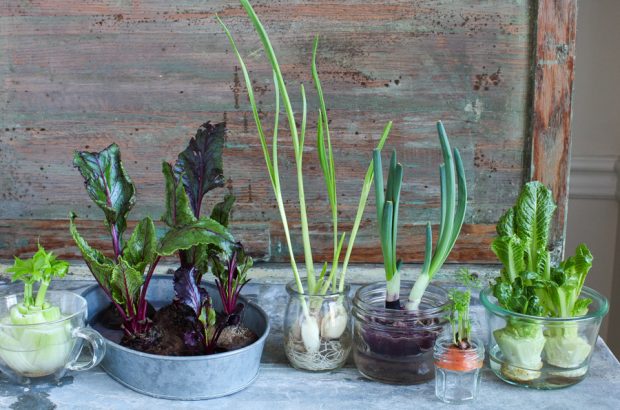How to Regrow Vegetable Scraps
by Aimee
Tips for turning kitchen compost scraps into pretty spring greens.
Even thought my daughter is just six years old, it’s clear that I’m raising a little environmentalist.
Clara carries a bag and picks up garbage on our forest walks, aghast at people who litter. Of her own free will, she turns off the water in the shower when soaping and is keenly aware of water conservation. She wants to know about everything from global warming to water pollution and is fiercely protective of nature.
This simple kitchen project started as a way to demonstrate to Clara how not all vegetable scraps need to end up the compost bin – many can sprout again if given the chance. You all know how I love a good lesson from the kitchen, especially if it promotes food sustainability.
Once you start looking, there are a thousand little ways we can make environmentally friendly choices in the kitchen. Regrowing vegetable scraps is just one of them.

Pictured from back left: green onion, green garlic, beets, romaine lettuce, carrots, turnip, red onion, celery and Napa cabbage.
As a kid, I can remember watching celery magically regrow and carrot tops send up tall green fronds when placed in water. It’s fascinating to see what still holds life from the produce drawer, even when it’s cut down to a mere stump.
A few weeks ago I snapped the iPhone photo above and shared it on Instagram, thinking that my followers would enjoy the inspiration for a little greenery in February.
My readers responded enthusiastically and had so many questions that I decided to follow up the photo with this post. Now these tips can live on here and you can reference it as needed, because I hope you will all start regrowing your veggies.
Not only is this a fun science experiment, but I’ve been cooking these little shoots as they sprout. Green onion, Napa cabbage, onion and green garlic are all delicious in a stir-fry or fried rice. Baby beet greens, celery shoots and romaine lettuce is harvested for salads, and carrot tops can be made into pesto.
How to Regrow Vegetable Scraps: Myths Debunked
For starters, please note that this windowsill kitchen garden is not *really* to supplement your diet. Sure, you’ll be able to nibble away at your greens, but we’re not producing tons of vegetables here. I’ve seen a few articles on vegetable regrowth that claims it ‘builds self-sufficiency’. Ahem. Regrowing enough vegetables to support your diet would take a lot of space and time. And, well, a garden.
For me the goals here are part kid’s science project, part zero waste initiative, and part edible kitchen mini garden. And it’s lovely to have a bit of greenery around in the middle of winter, especially when there’s a snowstorm outside.
This also needs to be said: we are not regrowing root vegetables. When beets, carrots , turnips, etc are placed in water, they send up green shoots and it is these leafy tops that we are enjoying.
However, it is possible to completely regrow some whole vegetables. Celery, for example, if tended to properly, will regrow into full stalks. Boc choy, Romaine lettuce, green onions, fennel and leeks will all (eventually) regrow to be full sized, as well.
How to Regrow Vegetable Scraps
Starting your windowsill garden is as easy as placing the ends or tops of a few kitchen produce scraps in about an inch of fresh water and setting them in partial sunshine. Your only maintenance is to change the water daily – now you see why this is such a good project for kids.
For an easy start with quick results, begin with green onion and garlic. Place about 3 inches of the white part of green onion – with the roots attached – in a jar and in a few days, you’ll start to see regrowth. For garlic, choose a whole bulb or individual cloves that have started to send out green sprouts – we tend to see this a lot in the winter months as the garlic gets older.
A few things I’ve learned along the way:
- Keep the regrowing vegetable away from a direct heat source or they will just bake instead of grow.
- Not everything will sprout. If you’ve waited a week and seen no sign of life, try again.
- The taste on the regrown vegetables will be milder than from fresh vegetables.
- Slimy bottoms are normal.
Which scraps to regrow
If you’re wondering which end of the vegetables to keep and place in water and which to toss in the compost, here’s a quick cheatsheet.
Grow these tops:
- Carrots
- Beets
- Turnip
- Radishes
- Daikon
Cut off about 1-inch of top and place in water but do not submerge.
Grow these roots/ends:
- Green onion
- Garlic
- Fennel
- Celery
- Romaine lettuce
- Bok Choy
- Leeks
- Onions
- Lemongrass
Cut off about 1 -3 inches of bottom and place in water but do not submerge.
A few of these, like fennel and celery, may be transplanted to a garden once springtime arrives, but I feel like that is a whole new post. There’s certainly lots of information on the web around this topic, so seek it out for yourselves. Happy growing!
Have you ever regrown vegetable scraps? Share your experience in the comments.
How to Regrow Vegetable Scrapsis a post from Simple Bites
© 2010-2017 Simplebites | All rights reserved - This feed is provided for the convenience of Simplebites.net subscribers. Any reproduction of the content within this feed is strictly prohibited. If you are reading this content elsewhere, please contact hello@simplebites.net to let us know. Thanks.

